ILC's Treatment for Spondylolysis /
Spondylolytic Spondylolisthesis
Having been adopted in over 54 countries globally,
the "Cellgel Method" for treating lower back pain
is now available in Japan
For those who have been told it was impossible to operate,
For those who have had recurrence of pain post-surgery,
A low-risk, outpatient treatment is now an option for you.
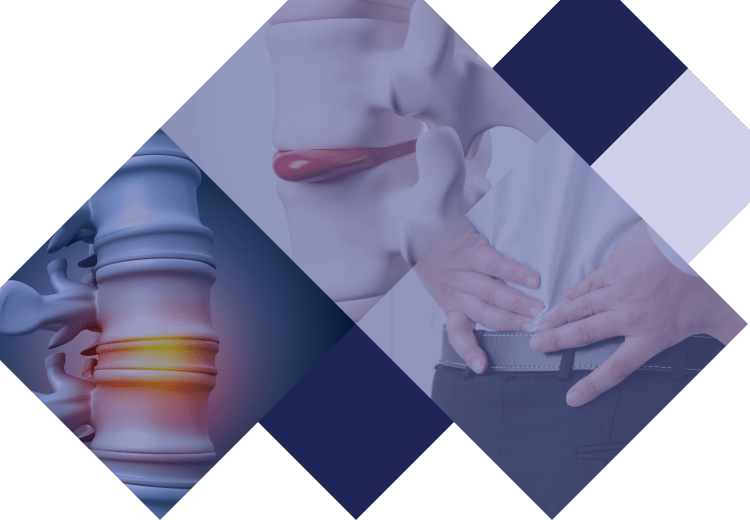
Contents
 Table of Contents
Table of Contents
- 1 What is spondylolysis / spondylolytic spondylolisthesis?
- 2 Main symptoms of spondylolysis / spondylolytic spondylolisthesis
- 3 Causes of spondylolysis / spondylolytic spondylolisthesis
- 4 Our approach to the treatment of spondylolysis / spondylolytic spondylolisthesis
- 5 Treatment at ILC
- 6 FAQ about spondylolysis / spondylolytic spondylolisthesis and treatment
This page provides information on the main symptoms and causes of spondylolysis / spondylolytic spondylolisthesis and our treatment procedures. The information includes the method of treatment, treatment time, and information about insurance. We use the Cellgel method, which is one of the most advanced methods in the world, and the characteristics of this method are also described in detail.
Please read this page especially if you have been told that you cannot be cured without surgery, if you have had surgery in the past but have not improved, or if you got better after surgery but the symptoms have recurred.
What is spondylolysis / spondylolytic spondylolisthesis?
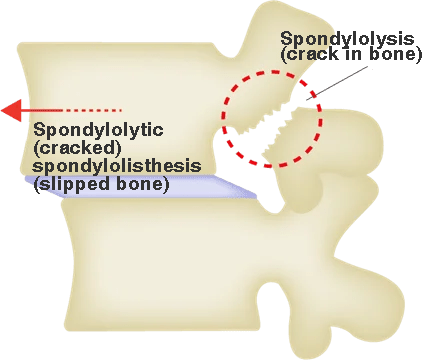
Spondylolysis is a condition in which stress is concentrated in the back portion of the lumbar spine, resulting in stress fatigue fractures (separations). It is said to occur most often in the fifth lumbar vertebra (the lowest of the lumbar vertebrae).
Spondylolysis is one of the most common causes of back pain in youth, making it the cause of 30% of all back pain in youth. In some cases, lumbar spondylolysis may be discovered in middle age or later, when lumbar spondylolysis is not noticed in youth and low back pain worsens.
Age of onset :
Junior high school boys and girls, upper elementary school boys and girls
Related Sports:
Soccer, track and field, baseball, basketball, volleyball
There have been cases even when the children were not involved in physical education classes.
In the early stages of spondylolysis, it is difficult to detect fracture findings on X-rays or CT, and MRI is necessary to confirm the findings.
If spondylolysis is detected within a short period of time after the injury, the rate of fracture fusion (probability of healing of the separated part) will be higher.
On the other hand, the longer the time between the discovery of the injury and the detection on the MRI, the more likely it is that it may fail to heal adequately, and pseudarthrosis (bone healed with jagged edges) will occur, in which the bone fusion ends halfway through the injury. Pseudarthrosis leads to lumbar spondylolisthesis, as the upper bone is shifted forward relative to the lower bone, centered on the separated area.
Characteristics of those predisposed to spondylolisthesis:
- Spondylolysis at age 11 or younger
- Bilateral spondylolysis
- Bone atrophy (localized loss of bone tissue)
When lumbar spondylolysis occurs at the age of 11 or younger, the bone fusion rate of the separated part is said to be about 60%, which means that in 40% of cases, the bones have failed to heal adequately.
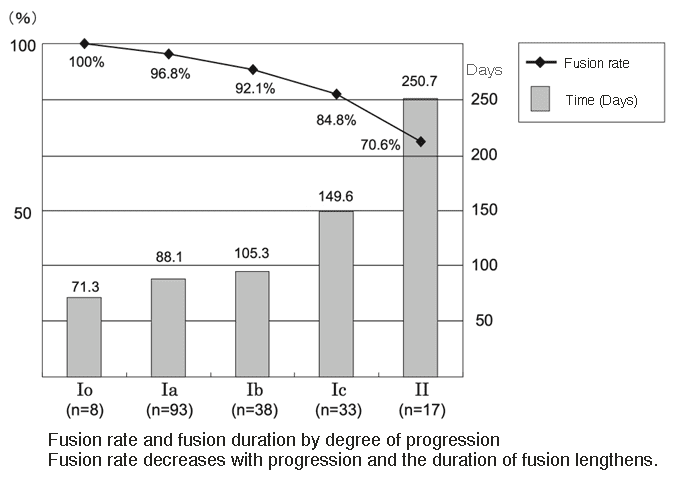
The rate of fracture fusion (probability of healing of the separated part) of the separation is reported to be 70-100%.
The later the separation is detected, the lower the fusion rate becomes.
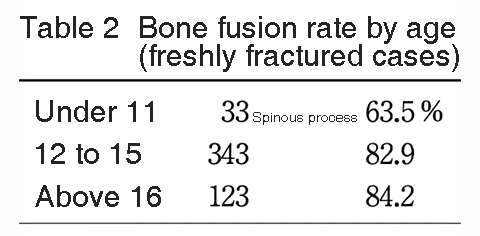
Citation:
Separation at age 11 or younger is associated with a lower rate of successful fusion
Main symptoms of spondylolysis / spondylolytic spondylolisthesis
Main symptoms shortly after a lumbar spondylolysis injury:
- Lower back pain (pain around the hips and around the lower back)
- Back pain that appears momentarily during exercise
- Lower back pain that appears when the lower back is bent backward
*The pain is characterized by a narrow range of motion and tends to be more noticeable after sports
Pseudoarthrosis (bone healed with jagged edges) may cause bone spurs around the area, and if the bone spurs come in contact with the nerves, they can cause sciatica which presents as pain in legs or buttocks.
Many patients who come to us with back pain as they age come to us because of pseudoarthrosis.
Some patients may develop intermittent claudication, characteristic of spinal stenosis, in which numbness increases after a long walk and becomes subsides after resting.
Main symptoms of lumbar spondylolysis
- Instability in the area where the spondylolisthesis (slipping) has occurred
- Lower back pain (pain around the hips and around the lower back)
- Pain and numbness caused by compression of spinal nerves
*Maudal nerve symptoms such as urinary and defecation disorders/perianal sensory disordes do not generally occur with lumbar spondylolysis.
If you have any of these symptoms, we recommend that you have them checked out.
Causes of spondylolysis / spondylolytic spondylolisthesis
The back half of the lumbar spine is shaped like a ring. Hence, the diagonal posterior portion of that ring is thinner and weaker than the rest.
Causes of spondylolysis include:
- Reduced flexibility of the hip joint
- Muscular weakness of the hip joint
- Repetitive lumbar extension (bending at the waist) and rotation (twisting) movements
- Repetitive impact movements such as landing from a jump
Specific Examples of Movements Causing Lumbar Spondylolysis (
- A:
Tight muscles in the front of the hip joint make it difficult for the leg to go backwards when running, leading to bending at the waist to extend the leg backward. - B:
The muscles in the front of the hip joint are tight, leading to one pushing the hips back and tensing the lower back instead of aligning the spine. - C:
If the muscles in the buttocks are tight, the hip joints do not move properly during twisting movements, causing the hips to twist excessively.
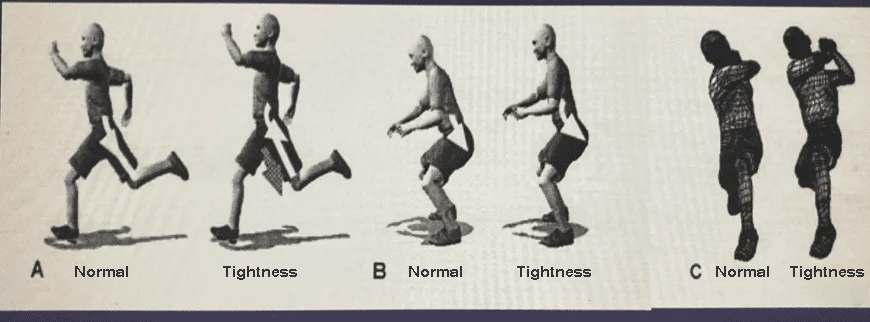
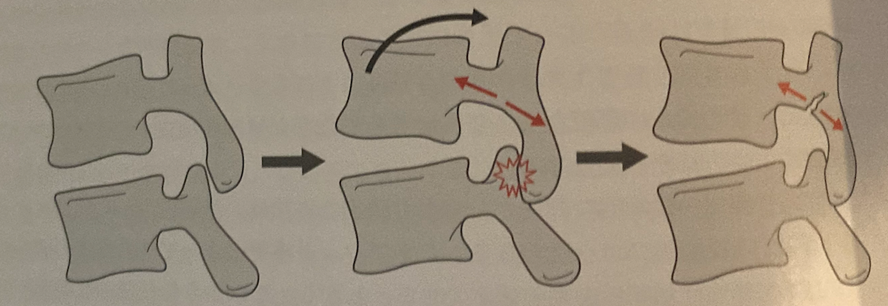
Our approach to the treatment of spondylolysis / spondylolytic spondylolisthesis
Generally, the first step in the treatment of spondylolysis / spondylolytic spondylolisthesis is conservative therapy. If symptoms do not improve with conservative treatment and are prolonged, surgery is often suggested.
However, conventional surgical methods such as lumbar fusion and posterior lumbar decompression require removal of the bone and even spinal fusion, and have high surgical risks and a high recurrence rate (within 2 years) of 30-46% because they do not treat the cause of the problem. Although there are now innovations such as endoscopic surgery and minimizing the size of the wound, the principle is the same, and since it does not treat the underlying cause, the risk and recurrence rate are still high.
Here at our clinic, we have the Cellgel treatent for spondylolisthesis. We can also accommodate elderly patients who are at high surgical risk or who wish to undergo revision treatment.
By repairing and regenerating the degenerated intervertebral disc, it can prevent the spine from becoming misaligned, which is the root cause of slipped vertebrae.
It also stabilizes the spine and prevents pain caused by pressure on the nerves.
Conventional Surgery
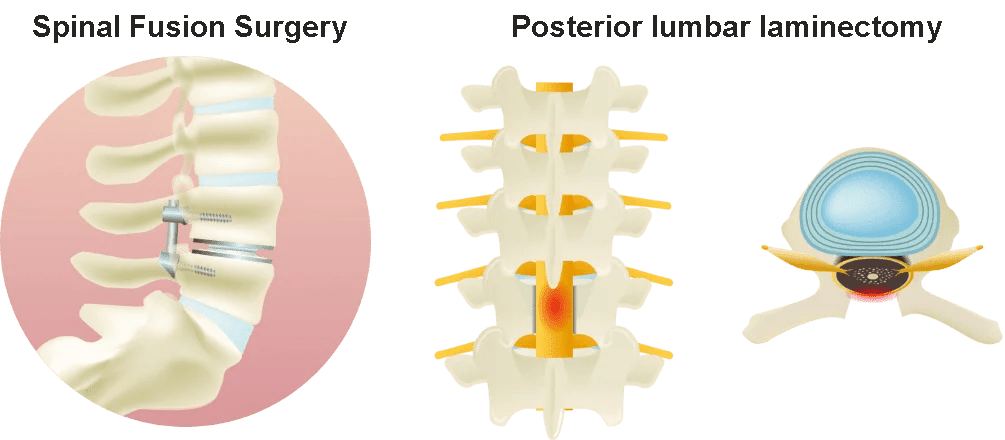
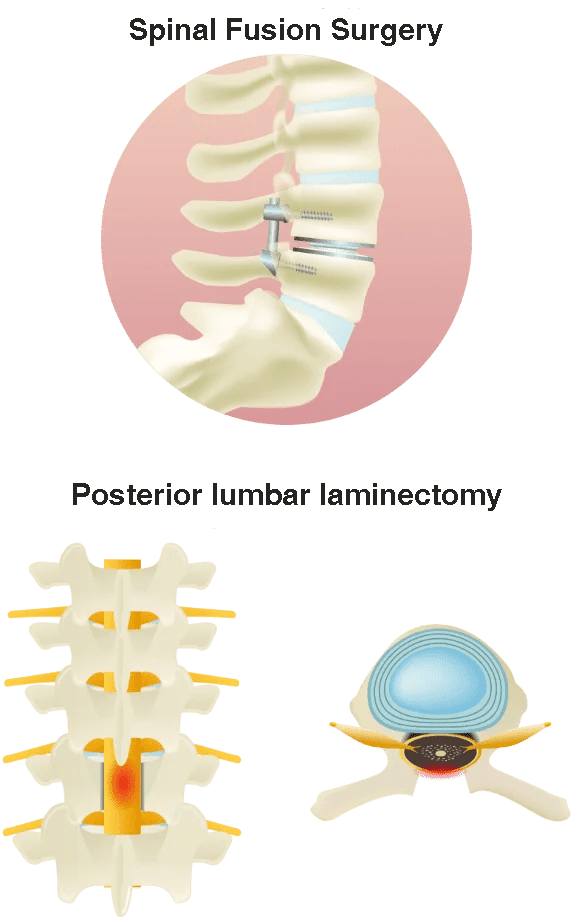
High risk, generally cannot be operated on a second time. High-risk treatment for the elderly. Also, the artificial material implanted cannot be used permanently and is likely to need to be replaced after a certain period of time.
Cellgel Method
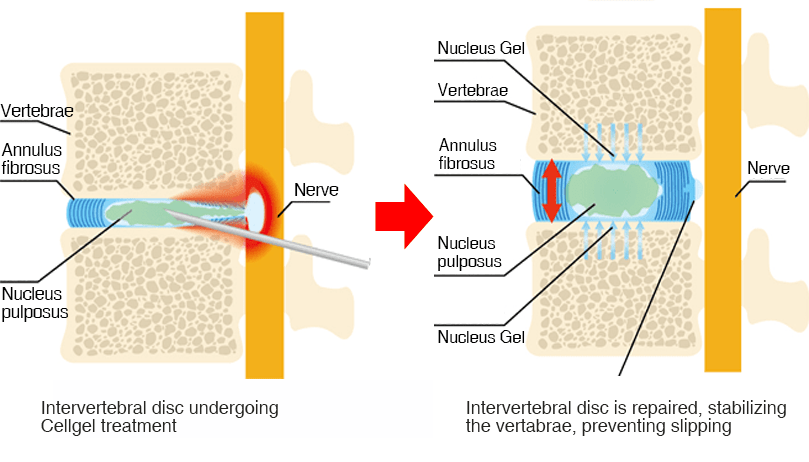
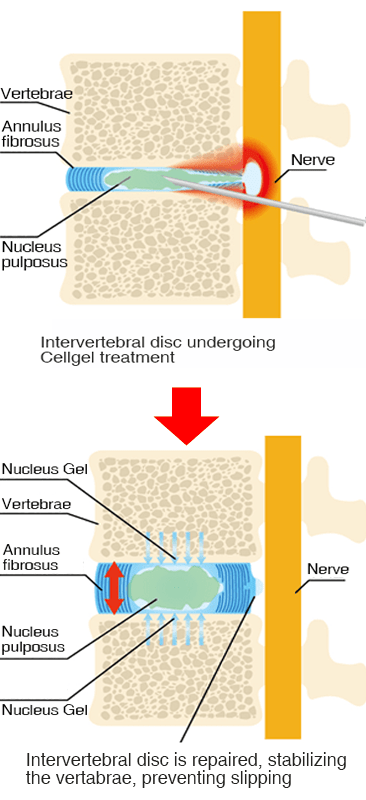
Since many of our patients come from far away,
we are happy to give free consultations to see which treatment is best for you
We'll diagnose your MRI images for free!
Treatment at ILC
There are four main treatments at our clinic.
As mentioned above, the root cause of each back pain disease is "inflammation and deformation due to aging of the intervertebral discs." Although the four treatment methods have different features and advantages, we would like to first introduce the "Cellgel method," which is the only one capable of intervertebral disc repair.
The Cellgel Method
About Cellgel
The Cellgel method is an advanced treatment for low back pain that has been implemented in more than 54 countries worldwide, predominantly in Europe.
As with other treatments, it does not decrease the disc volume, and since the drug remains in the disc as a gel-like implant after treatment, the disc can be preserved. Recent studies have also shown that the volume of the disc increases after treatment.*1
It is also thought that by repairing the disc and preventing leakage of the Nucleus Pulposus, the disc itself will restore its normal function with its own regenerative ability (*2).
It is particularly recommended for patients who are concerned about the risk of conventional disc surgery (MED, PELD, etc.).
*1 Source: European Journal of Radiology 109 (2018) 101–107 , Efficiency of an ethyl alcohol gel in symptomatic disc hernation
*2 Source: International Journal of Spine Surgery Vol. 15 Appendix 1 from regenerative treatment of disc degeneration
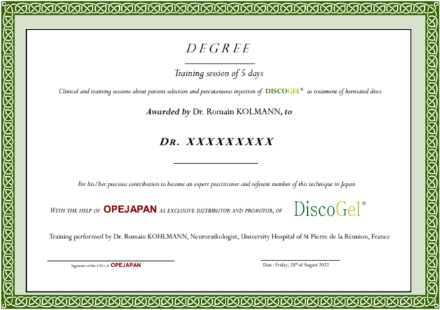
"Very good or good results were obtained in 202 (91.4%) of the 221 patients in group A. Of the 44 patients in group B, 37 patients (84%) presented very good or good results and in 9 (82%) of the 11 patients of group C, we obtained similar results. There was no allergic complication in any of our patients. Long-term follow-up magnetic resonance showed a dramatic reduction in hernia volume."
- Dr. J. Theron, one of the world's leading experts in the treatment of Celgel method, from his research article "Percutaneous Treatment of Lumbar Intervertebral Disk Hernias With Radiopaque Gelified Ethanol - A preliminary study."
Merits of Cellgel
- Possibility to repair intervertebral discs where unable to using surgical or laser treatment
- As the disc is repaired, the disc itself regains its original normal function through its own regenerative ability
- The Cellgel method uses local anesthesia over general anesthesia used in conventional surgery, making it less burdensome on the body
- Treatment is done with a thin needle, so the wound is minimal and recovery is rapid
- Treatment is very short, allowing for outpatient day treatment
- Safe, modern treatment proven in more than 54 countries around the world
Flow Cellgel Treatment Process
-
01 Examination

MRI and X-rays will be taken, followed by a doctor's diagnosis.
If the diagnosis proves the Cellgel method suitable, treatment can begin that same afternoon. -
02 Before

TreatmentAfter entering the treatment room and administering local anesthesia to the lower back, a needle is inserted into the intervertebral disc identified in the examination.
A contrast scan is performed to confirm the location of the damaged disc. -
03 Treatment
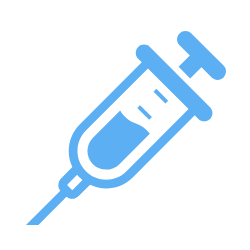
The Cellgel drug is administered to the damaged area while confirming the location of the disc with a fluoroscopy device.
Once the drug has been absorbed, the needle is removed and the bleeding is stopped.
-
04 Returning

HomeAfter the treatment, the patient rests in a private room for about an hour, and then allowed to go home after the post-treatment examination.
*Resting time depends on the patient's symptoms and condition.
Price Cost of Treatment for the Cellgel Method
| Number of Discs Treated |
1 disc | 2 discs | 3 discs | 4 discs | 5 discs |
|---|---|---|---|---|---|
| Treatment Cost | 1,320,000 JPY | 1,430,000 JPY | 1,540,000 JPY | 1,650,000 JPY | 1,760,000 JPY |
Swipe left/righ
* The cost of treatment is indicated including taxes.
*If treatment is performed at our clinic, all examination/diagnosis costs and test costs such as MRI are included in the above costs.
*This treatment method is not covered by Japanese health insurance, so you will have to pay for the entire treatment yourself.
*Payment by credit card (VISA, MasterCard, JCB, American Express, Diners, Discover) is also possible.
*If you would like rehabilitation (low back pain specialized rehabilitation), it is also possible to pay by bank transfer.
*If you live and work in Japan, you can receive a tax refund by filing your final medical expense return.
FAQ FAQ about spondylolysis / spondylolytic spondylolisthesis and treatment
-
QWhat's the difference in the reccurence rate between Cellgel and conventional surgery?
-
A
Surgical procedures, which began in the 1960s, aimed to remove and sometimes fix deformed bones and herniated tissue. However, new bone damage caused by screws and the lack of fundamental treatment (repair of the intervertebral disc annulus fibrosus) resulted in the appearance of additional back pain and recurrence rates.
Therefore, in the 1980s, the need for fundamental treatment increased, and the intervertebral disc treatment (Cellgel) that we provide at our clinic began. Cellgel, in particular, have been proven to repair and regenerate the intervertebral disc, resulting in not only improvement of symptoms, but also an extremely low recurrence rate.
-
QHow is the disc to be treated determined?
-
AThe doctor will spend about 30 minutes with the patient while looking at the MRI and X-ray images to determine the cause of the condition, determine the treatment area, and explain the corresponding treatment method to the patient. MRI images show the main factors that contribute to back pain (disc, nerve, ligament, and joint), such as changes in shape, pressure on the nerve, presence or absence of damage, and inflammation. The x-ray image mainly confirms the condition of the bones.
-
QWhy is the Cellgel method applicable to cases where surgery showed no improvement?
-
ADuring surgery for disc herniation, the prolapsed herniation is removed, but the damaged disc remains intact. As a result, fresh nucleus pulposus components leak from the damaged disc and inflammation persists. On the other hand, our treatment can treat the disc injury itself, thus suppressing inflammation by reducing the fresh leakage of nucleus pulposus components.
-
QMy back pain may temporarily worsen after treatment. How long will it last?
-
AThe reason for the lower back pain is that spinal ligaments that have been compressed are stretched; the lower back pain lasts for about two weeks and then subsides.
-
QWhat level of exercise can I perform after treatment?
-
AGeneral recreational exercise and sports can be done without any problem. For professional athletes, the possibility of new disc damage is high and should be discussed in consultation with a doctor.
-
QPlease tell me about what I should be cautious about after treatment.
-
ADuring the first few days after treatment, the patient should rest and avoid prolonged sitting, heavy lifting, twisting, bending, or strenuous exercise. Patients should be able to perform routine tasks one week after treatment and should be able to perform light exercise by the second week. Weight training is allowed after 3 months.
-
QIs the treatment covered by the Japanese national health insurance?
-
ANo, it is not covered by the national insurance. If you have life insurance, you may be eligible. Please feel free to consult our staff regarding this matter.
-
QHow long must I wait to be able to walk after treatment?
-
AIt is an outpatient/day treatment, so you can walk about an hour after the surgery.
-
QHow many doctor visits do I need to make before treatment?
-
AWe require an MRI to be taken within three months for remote diagnosis, either with our affiliated clinic or from data sent by you. You can receive treatment on the same day after phyiscal diagnosis. You may also request only the diagnosis and come back only for the treatment at a later date.
-
QCan I fly immediately after the treatment?
-
AIf there are no problems after the treatment, you may fly. If there is any pain after the treatment, flying may not be recommended depending on the doctor's evaluation.
-
QWhat should I be cautious of if I have spondylolysis / spondylolytic spondylolisthesis?
-
AIf you are diagnosed with spondylolysis or spondylolisthesis, the first step is to prevent further disc and bone degeneration. If you perform a lot of activities or tasks that put stress on the lower back, reduce the frequency of such activities or tasks, and listen carefully to your doctor's advice to determine the next steps.
-
QDoes spondylolysis / spondylolytic spondylolisthesis cause deformation of the entire spine?
-
AYes, other back disorders may occur as the slip progresses.
In some cases, spinal canal stenosis, which compresses nerves and narrows the nerve pathways, and disc herniation due to disc deformity may also occur.
-
QIs there a way to fully cure spondylolysis / spondylolytic spondylolisthesis without surgery?
-
AUnfortunately, there is no complete cure for bone deformities.
It is possible to reduce inflammation and prevent the worsening of pain and progression of symptoms by relieving symptoms and improving the overall physical condition of the patient.
-
QAre there medications to cure spondylolysis / spondylolytic spondylolisthesis?
-
A
Medication will not fundamentally cure the disease.
However, medications may be prescribed to relieve pain and improve blood flow. For severe pain, it may be necessary to take painkillers. Patients who have been taking medication for a long time may experience other pain and side effects if the medication is abruptly stopped.
-
QCan I continue working if I have spondylolysis / spondylolytic spondylolisthesis?
-
A
It is possible to continue, depending on the severity of the symptoms.
However, if your job involves a lot of desk work or heavy labor, you need to refrain from such work as much as possible, as it is hard on the lower back.
If it is difficult to change your work environment, consider improving your physical condition, posture, and muscle strength. If these methods improve the condition, we recommend that you continue to use them.If there is no improvement, we recommend that you consult a doctor and receive a diagnosis.
ILC Rehabilitation X Spondylolysis / Spondylolytic Spondylolisthesis Treatment
Although the Cellgel method can repair and regenerate the disc itself, and other treatment methods we offer can fundamentally heal the disc; it is possible that the cause of back pain is not only the disc, but also muscles, joints, and ligaments that are affected by the disc.
In cooperation with our rehabilitation specialists, we recommend treating back pain caused by muscles, joints, and ligaments together.
We also offer a short-term intensive program for patients who live far away or overseas.
-
ILC's Low Back Pain Treatment
Outpatient Treatment
Improve back pain disorders/
symptoms in relation to the nerves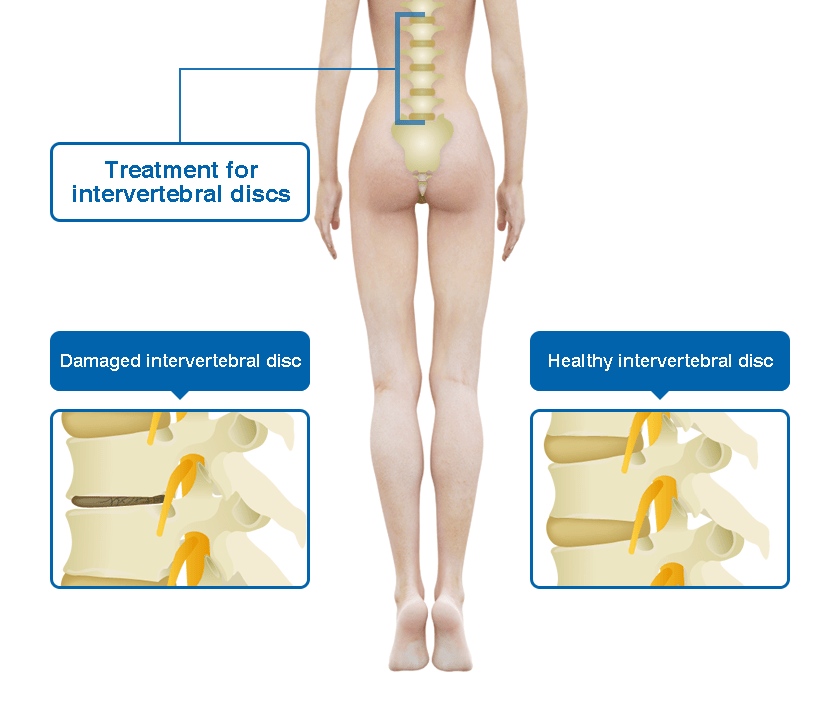
-
ILC's Rehabilitation Program
Specialized Low Back Pain Rehabilitation
Improve back pain disorders/symptoms in
relation to the joints, muscles, ligaments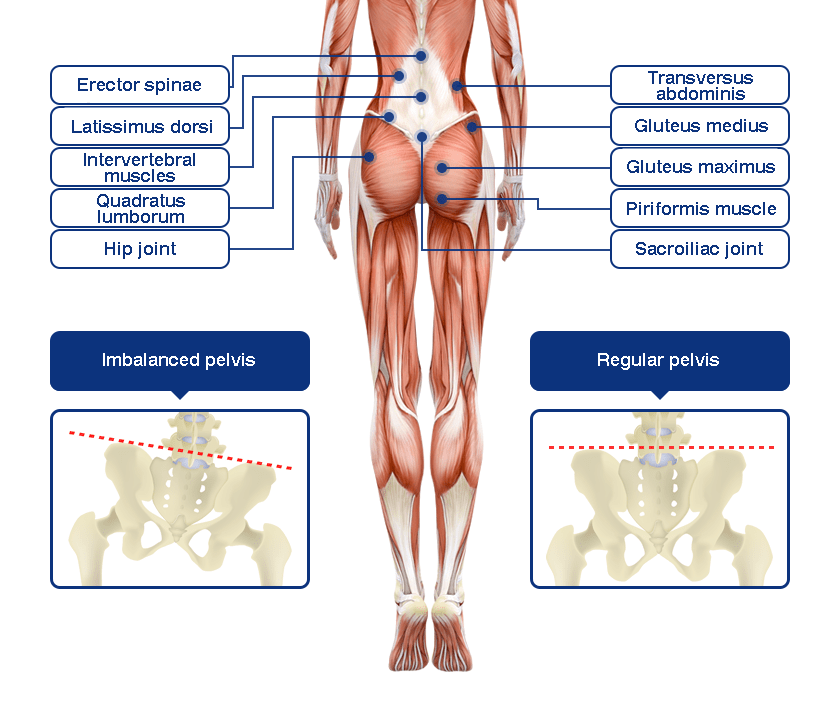
-
01
ILC's Specialized Back Pain Rehabilitation
Our Rehabilitation Approach to Spondylolysis / Spondylolytic Spondylolisthesis
Spondylolysis / spondylolytic spondylolisthesis may occur acutely during adolescence, or it may occur during adolescence and recur around middle age.
In the acute phase during adolescence, it is extremely important to keep the spine at rest and promote healing.
In order to promote this healing, our rehabilitation facility provides acupuncture, moxibustion, nutritional guidance, physical therapy, and correction of chronic body movements that may have caused the damage.In the acute phase immediately after the onset of symptoms, acupuncture and moxibustion are used to relieve pain and promote healing. In addition, since nutrition is extremely important for bone fusion, a nutritionist will provide nutritional guidance according to the physical condition of the patient.
Once symptoms have settled and the bone has healed appropriately, exercise therapy is performed to correct the chronic triggers.
In the case of low back pain around middle age, the bone itself is not the problem, but the symptom recurs due to decreased stability/increased stress in the area where the spondylolisthesis has occurred.
Possible reasons for this recurrence are:
- Decreased stability due to disc degeneration
- Decreased core strength
- Increased stress on one part of the back
The Cellgel method is needed to reestablish disc stability, and exercise therapy is needed for the remaining causes.
-
02
ILC's Specialized Back Pain Rehabilitation
How to Evaluate Spondylolysis / Spondylolytic Spondylolisthesis
For Adolescents
In order to understand the severity of the spondylolysis and/or spondylolisthesis, a consultation will be held with the doctor based on the MRI imaging findings.
After the initial injury, a rest period of about 4 weeks will be given in consideration of the condition of the bones.
During the rest period, we will evaluate the hip, ankle, and other potentially problematic body parts.
After 4 weeks, the patient is gradually allowed to move around; the entire body, including the thoracic spine, is evaluated by moving the body slowly.For Adults
In order to understand the state of spondylolysis and/or spondylolisthesis, a consultation is held with the doctor to determine which part of the spine is under stress based on imaging findings and the condition of the intervertebral disc.
Using the findings as a reference, we will evaluate the aggravating and mitigating factors of the symptoms in the posture and movements of daily life while actually moving the body slowly.Aggravating factors are defined as movements that should not be performed, and mitigating factors are symptoms that can be alleviated by doing certain body movements. We will comphehensively evaluate these factors with muscle strength and stiffness, and explore the nature of the symptoms.
In addition, since inflammation is very closely related to the state of the physical body, we will also conduct a medical interview and evaluate the level of oxidative stress to evaluate the factors contributing to inflammation.
-
03
ILC's Specialized Back Pain Rehabilitation
Rehabilitation Treatment for Spondylolysis / Spondylolytic Spondylolisthesis
Treatment methods for lumbar spondylolysis in adolescents
The main treatment is stretching, core training, and corrective programs. The following are actual examples from the rehabilitation program.
- 1. Initial Period (Weeks 0 to 4)
- Core muscle (endurance) training + postural modifications
- Stretching of hamstrings and gluteal muscle groups on back
- Mobility of glutes and hamstrings
- Dietary guidance and implementation
- 2. Middle Period (Weeks 5 to 12)
- Initial training + lower limb strength training
- Stretching of Achilles tendon and hamstrings while standing
- Dietary guidance and implementation
- 3. Final Period (After week 13)
- Initial + middle period training + jogging
- Form modification for sports
- Aerobic exercise using aerobic bikes and other machines
- Dietary guidance and implementation

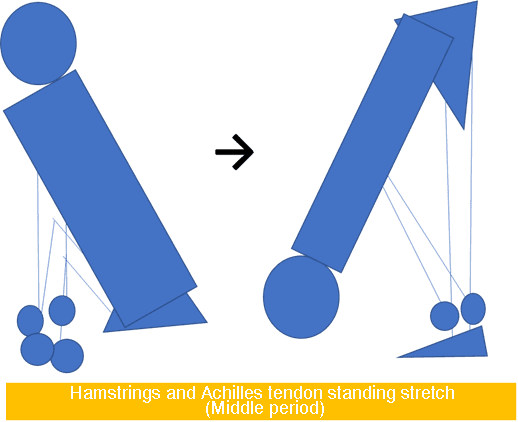
Spondylolytic Spondylolisthesis
This is more common in adolescents and middle-aged women.
Due to the vertebrae sliding forward, nerve compression and low back pain may occur.
A common treatment is to stimulate blood circulation with acupuncture and heat therapy to control pain and promote healing.- 1. Rehabilitation for Adolescents
- Wearing a corset
- Stretching
- Inhibit excessive movement during sports, improving form
- Correcting habitual movements to avoid injury
- 2. Rehabilitation for Adults
- Weight adjustment
- Correcting posture, especially middle back
- Gaining core muscle strength for intervertebral stability
- Improving range of motion of thoracic spine and hips
Postoperative rehabilitation is performed with considerations to pain and numbness due to physical compression.
We also provide dietary guidance, posture, form modification in sports, and lifestyle guidance.
In addition to physical therapists, we also have personal trainers on staff to provide comprehensive care.04ILC's Specialized Back Pain Rehabilitation
Treatment Period for Spondylolysis / Spondylolytic Spondylolisthesis Rehabilitation
The treatment period for spondylolysis often takes several months to six months, as the bones need to completely heal.
Even after treatment is completed, the patient is able to lead a normal life immediately; a period of rest and rehabilitation is often required.
Rehabilitation often takes two to three months even with early detection and early treatment, indicating that a lot of time is required for treatment of lumbar spondylolysis.
However, this is a rough estimate of the length of treatment and rest period when spondylolysis is detected early, so if it is detected late and is advanced, it will take even longer to heal.If the spondylolysis develops into spondylolisthesis (slippage), the healing of the bones does not occur normally and it takes time to stabilize, so the treatment period is longer than that for spondylolysis.
In addition, if the patient has neurological symptoms such as numbness and pain, it will take even longer.
Even after the Cellgel treatment, the patient may not be able to lead a normal life immediately, but may have to rest for a period of time depending on the condition.We aim to achieve 100% effectiveness of treatment while incorporating the latest technology, so we spend at least 30 minutes with each patient to carefully and meticulously examine the patient's concerns in order to make a proper diagnosis and propose the most suitable treatment methods.
We are certain to find a way to alleviate or eliminate the pain and numbness you are experiencing, so please do not give up and give us a call instead!
- Tadaaki Minowa, Clinic Director

- 1. Initial Period (Weeks 0 to 4)


